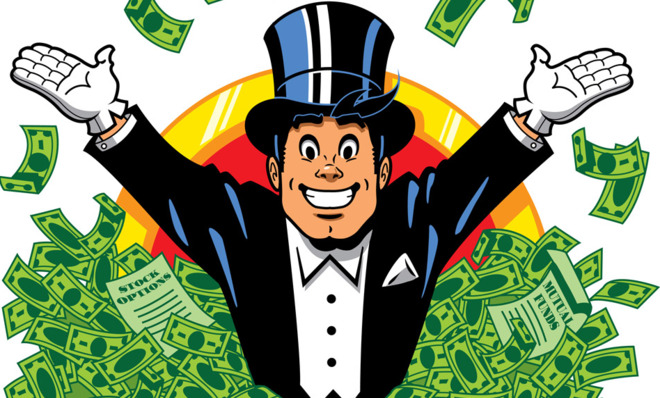The Fed's stimulus worked out great (if you're rich)
Inflation wasn't the problem. Inequality was.

I was wrong about quantitative easing.
Back in 2009 when the Federal Reserve began its operation of creating new money to buy government bonds and mortgage-backed securities, I worried that the unconventional measure would lead to excessive inflation.
After getting the housing bubble so dramatically wrong — Fed chair Ben Bernanke claimed throughout 2005 and into 2006 that there wasn't a housing bubble — I worried that the Fed was now making another severe error, and that a nasty bout of '70s-style inflation (or worse) was coming.
The Week
Escape your echo chamber. Get the facts behind the news, plus analysis from multiple perspectives.

Sign up for The Week's Free Newsletters
From our morning news briefing to a weekly Good News Newsletter, get the best of The Week delivered directly to your inbox.
From our morning news briefing to a weekly Good News Newsletter, get the best of The Week delivered directly to your inbox.
I was hardly alone in this conviction. In 2010, a long list of very well-known economists, historians, hedge fund managers, and policymakers — including Kevin A. Hassett (of Dow 36,000 infamy), Harvard historian Niall Ferguson, the Congressional Budget Office's Douglas Holtz-Eakin, and Stanford economist John B. Taylor — wrote an open letter to Ben Bernanke in The Wall Street Journal, arguing that quantitative easing should be "discontinued" because of its inflation potential.
Except they were wrong, and so was I. Inflation remained low and stable, and the dollar remained stable, too.
Over the years that followed, as my expectation of excessive inflation failed to materialize, I re-assessed why I had been so wrong. The Fed wasn't flooding the economy with new money. It was simply printing money to make up for the shrinkage in the money supply from the financial crisis, which destroyed a lot of monetary (and shadow monetary) assets. The Fed was re-inflating the deflated money supply, not inflating it beyond the historical trend or the economy's demand for money. Even in 2013, after all of the Fed's money printing and ultralow interest rates for four years, there was still less money in the economy than before the financial crisis.
So I think that with the benefit of hindsight, the Fed was right to engage in the policies that it did. Bernanke argued that replacing yielding assets, like bonds and mortgage-backed securities, with zero-yielding cash incentivizes investment in productive ventures (like buying stocks), which in turn lowers unemployment and increases overall economic activity. And now, with unemployment down to 6.1 percent and the size of the economy much larger than its pre-2008 peak, that seems to have worked. The investment really is trickling down.
A free daily email with the biggest news stories of the day – and the best features from TheWeek.com
But that isn't all it has been doing. Inflation wasn't the problem with the Fed's policy; its effect on inequality was. The stimulus has been benefiting the rich over everyone else.
New York Times readers might be surprised, since Paul Krugman has written a column saying that disagreeing with the Fed's monetary easing is basically the preserve of the rich. The wealthy, he says, have the most to lose from low interest rates and quantitative easing, because they "derive an important part of their income from interest on bonds, and low-rate policies have greatly reduced this income."
Now, there's no doubt that low interest rates hurt those sitting on savings accounts or bonds. But the evidence shows that the net effect has been the opposite. As this 2012 Bank of England study suggests, the wealthiest 5 percent of the population (in other words, the people who own most of the stocks) benefit the most from rising stock prices and have access to lots of very cheap money to invest. That may have contributed to soaring inequality in the U.S. during the recovery, which has seen the overwhelming majority of income gains — 93 percent — accrued go to the top 1 percent.
Could the Fed have done more to stop itself from benefiting the rich over everyone else? Well, the Fed can mostly do what it wants so long as it can frame it in terms of meeting its chartered objectives of full employment and low inflation. Instead of firing its monetary cannon for the benefit of big banks and institutional investors sitting on bonds, Fed policymakers could have fired the monetary cannon for Main Street, too. They could have bought up consumer debt — credit card debt, distressed mortgages, and student loan debt — and allowed debtors to refinance at more favorable terms. They could have even opened channels to lend directly to individuals and businesses at low interest rates, getting around the dysfunctional financial system to put money directly into the productive economy. Or they could have literally thrown money out of a helicopter, as Milton Friedman once (half-jokingly) suggested.
I still think that what the Fed did was much, much better than doing nothing. But unlike the inflation paranoia which Krugman rightly condemns, the evidence shows that accelerating inequality is the price paid for a monetary policy that is essentially a form of trickle down economics.
John Aziz is the economics and business correspondent at TheWeek.com. He is also an associate editor at Pieria.co.uk. Previously his work has appeared on Business Insider, Zero Hedge, and Noahpinion.

